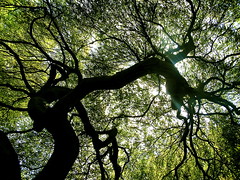The term “viewpoint” describes the camera’s position in relation to its subject—near, far, above, below, for instance. Many photographers never change their viewpoint. Ninety-nine percent of the time, they hold their cameras at chest or eye level and shoot straight ahead. Doing so allows them to take clear pictures of buildings, animals, people, plants, cars, and landscapes, so it’s not a bad strategy.
However, changing your camera’s viewpoint can produce some interesting and unexpected results. Every photographer should try this. For example, suppose you’re taking pictures of the family pet. You could focus on its face, its entire body, or some detail. But what if you changed your viewpoint and crawled below the animal or climbed above it. You might get a picture like this:
Varying your viewpoint works with people as well. Portraits do not always require faces. You can take some wonderful pictures of people without ever shooting a face. Search for the shot that will capture a telling posture or detail. Try hunkering down close to the floor, stting on a ladder, or shooting from some other unusual vantage point.
Lest you think I have a foot fetish, let me assure you that varying the viewpoint works with plants, machinery, and almost anything else you can think of. I take many pictures of Japanese maple trees, for instance. I love their color and the shape of their leaves and branches. One day, instead of shooting yet another standard tree picture, I crawled underneath the canopy of a Japanese maple and shot straight up. The result was unusual but striking.
Most photographers understand the concept of viewpoint but then forget about it. Try not to. The next time you are shooting and not under pressure, start by taking the obvious shots. Then vary your viewpoint to see what happens. Get above, below, or inside your subject. Walk far away, or snuggle up close. Angle your shot, or create a silhouette. Have some fun with your camera and see what happens.












These are good tips, and I am guilty of not working all the possible viewpoints when I’m out. The times that I do try different things, I usually end up liking those shots more than the original-viewpoint shots.
I love the low vantage point, which is one of the main reasons why I have continued with a Canon PowerShot Pro 1 and its swivel display. Tomorrow’s photo on my daily photography blog has a good example – with the camera practically on the ground (here’s a sneak preview). The photo currently at the top of the page would probably also have given a DSLR photographer back pains!
My advice is to pick a focal length and stick with it e.g. 50mm. You should find yourself moving to frame the picture.